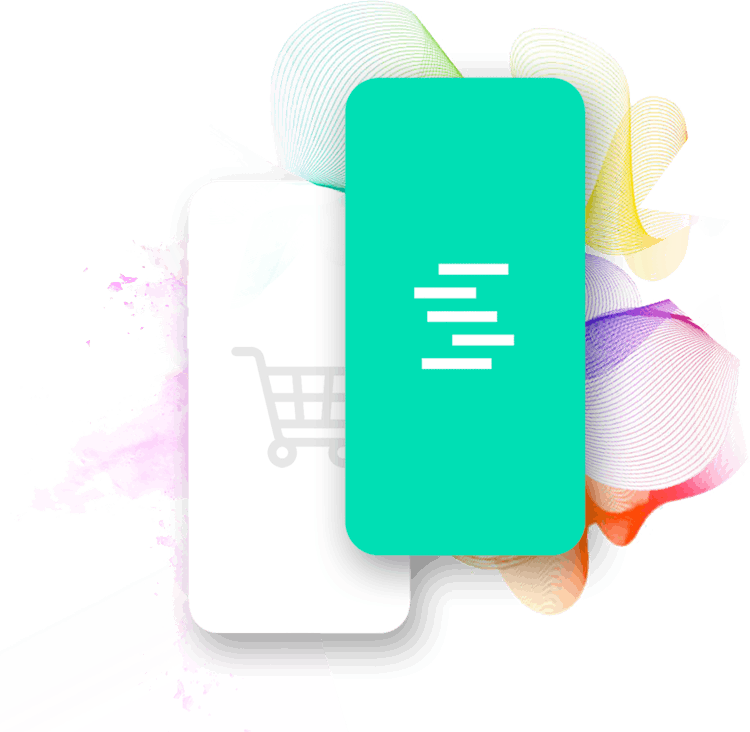If you plan it well, post-purchase communication can be the cherry on top of your marketing strategy. It can improve your customer service, shorten the purchase cycles, and increase the customer lifetime value. So how do you make your post-purchase email communication effective? The seven rules I've listed below will help you with this.
Why is Post-Purchase Communication Important?
Do you remember the last time someone told you about the great online store they'd found and really enjoyed shopping in?
No? And do you know why?
Because it wasn't a remarkable experience. It didn't engage all their senses.
In the online world, it's difficult to make your audience feel the sensations they are likely to experience in a physical store. You don't get to hear the music, smell the different scents, or touch the products with your hands. Those are the drawbacks of running an online business as opposed to an offline one.
At the same time, there are clear benefits to selling your products online. Achieving scale, for example, is much easier when doing it on the web. Unless you had a number of shops and even more employees, you wouldn't physically be able to sell to thousands of customers across the globe. Not to mention maintaining good relationships with them.
"Achieving scale is much easier for an online, than offline, business."
And on top of that, you've got access to many metrics through which you can analyze your business performance. For example, you probably know how much it costs for you to acquire a new customer and which channels are most effective. You may even know how much money on average every user is going to spend in your online shop, i.e. what's their customer lifetime value.
These two metrics alone should tell you that it's worth engaging your existing customers and making sure they stay loyal to your brand.
Post-purchase communication will help you reach this goal, so that every time a new customer makes a purchase, they won't be leaving your site for good, and you won't have to win them over again.
Of course, cost-reduction isn't the only benefit of post-purchase communication. It can also improve your ROI by reinforcing positive experiences. A study by a company called Medallia, published in Harvard Business Review, has shown that customers who had the best past experience spend 140% more compared to those who had the poorest past experience.
So your post-purchase communication has to be planned in such a way that it reinforces the positive feelings your customers had throughout the purchase process – from the research phase, to the order placement, and up to the moment they've received the actual product.
What if the customer had a negative experience? Post-purchase communication can help you transform it into a positive one, by providing you with a better overview of the customer's needs, and giving you a chance to serve them better value in the future. In fact, another study published in the Harvard Business Review shows that it is often more efficient to win your customers back when they're struggling, rather than put all your efforts into delighting them.
In other words, the emails you send after someone's placed an order are meant to act as the extension of your physical cash register or customer enquiry point, where customers can ask questions and have their doubts cleared.
7 Rules of Effective Post-Purchase Email Communication
So now that you know the potential value of post-purchase communication, let's figure out how to design it so that it can work for your business.
1. Be quick
How does a customer feel as soon as they've placed an order? Excited about the product that will soon be arriving at their doorstep? Or maybe slightly worried that the website crashed a few times, they had to spend their hard-earned money, and haven't received the payment confirmation yet?
Whatever the case, you want to follow up on this – and quickly. You have to reinforce the positive feeling of excitement that should accompany the shopping experience at your store. Overcome any potential doubts or worries by confirming that everything is going to be fine, the product they've fallen in love with is on its way, and they can start thinking of where they're going to use it.
Source: Shipping confirmation email from GearBest.
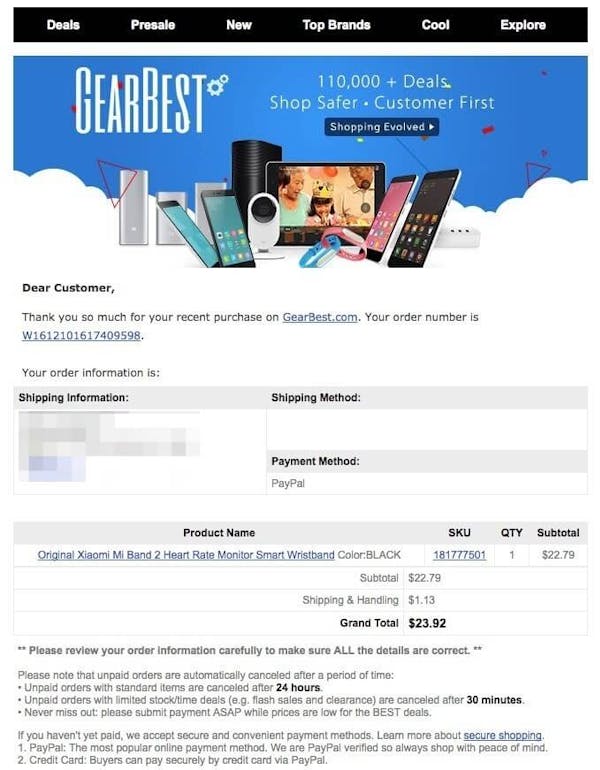
2. Let Them Remember You
Consumers experience products in various ways. Let's take your favorite denim jacket as an example. Every time you open your wardrobe, try the jacket on, or wear it to work, you'll be able to quickly recall the name of the brand you got it from. Am I right?
Now let's take the ink cartridge replacement you bought for your printer. It just helps you print out your documents and it's probably cheaper than the ones recommended by the manufacturer of your printer. But can you recall the website you got it from? Chances are, you can't. Or if you can, you don't have any emotional connection to it.
But what happens when you need to buy something similar in the future? In the case of the jacket, you will just type in the website address in your browser off the top of your head or do a quick search in Google. As for the ink cartridge, you have to either search through your email inbox or repeat the search process all over again – hoping that you will recognize the website by its looks.
As a business, you don't want the latter to happen. You have to make sure your brand stays in your customers' minds so that when the need reappears, they'll think of your website straight away.
To achieve that you need to first make sure your communication is branded and memorable. Any information about the product or the shipping details should be sent by you, not the dispatching company. After all it’s you who they've been dealing with this whole time and will be reaching out to if they have any questions.
The second thing you need to do, is to communicate, regularly. You may be wondering – How often should I send emails to my customers? There isn't a single right answer as it will depend on the type of business you are in and the products you are selling. In most cases, at least once a month. Ideally however, you'll have enough valuable content to send out an email at least once a week.
To be safe, just check your emails' performance. If you see that your opt-outs are getting out of control or subscribers are losing interest in your content, then you should turn it down a little. You can also simply give your readers a choice, either through a preference center or a separate mailing list for those who don't want to hear from you that often.
Last but not least, you should offer your audience other ways to stay in touch. They might not read their email as often as they check their social media channels. Or maybe they prefer to receive web push notifications or SMS text messages? By increasing the number of touch points through which your users can interact with the brand you are improving your chances of staying in their mind for longer, and being remembered.
3. Show Good Manners
This rule shouldn't even exist but the reality is unfortunately different. Both in the offline and the online world, people should be genuinely kind to each other and show good manners.
Saying thank you after someone's made a decision to shop at your store is one of such situations. They could have chosen to spend their money elsewhere but they chose to do business with you. Why not return the favor?
Nothing is stopping you from following up with a simple thank you message. An automated email can reassure them that they have made a good decision. On top of that, it can show them that you put a lot of effort into how your products are made and who they are purchased by.
4. Be helpful
Another rule that will make your post-purchase communication effective is to make it helpful. This one is important especially when it comes to more expensive products. When a customer makes a decision to purchase something valuable, they most probably want it to last for as long as it's possible. That means they will appreciate all the tips and guidelines that can help them take better care of the items they have just ordered.
If you have any video tutorials, FAQs, or recommendations – now is the time to use them. Add them into your post-purchase automated email sequence and make sure your products last longer and act as a physical advertisement of your brand.
Another way that you can be helpful is through sending replenishment emails. Through those you can remind your customers that it might be the best moment to make another order, before they run out of their favorite product.
Source: Useful cart abandonment email reminding the customer about products for their dog.
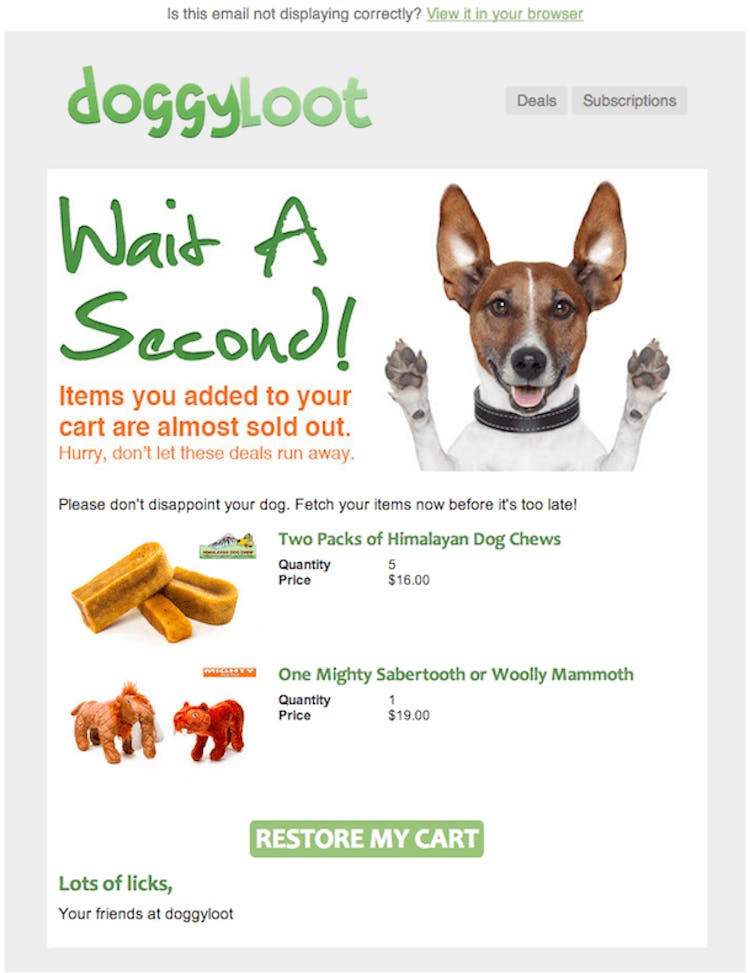
5. Open up to Feedback
Although I've mentioned this in one my last articles, I still feel it's very important to ask your customers for feedback. There are two main reasons for this.
First of all, consumers trust online reviews almost just as much as they trust recommendations from their actual friends. That means using them as social proof can help you sell your products more easily.
Secondly, thanks to feedback you can get into your customers' minds. You can learn about the concerns that they have, product aspects they find important, or the kind of language that they use to describe your products.
Genuine reviews are invaluable. And that applies even to the negative ones. Following the old adage "there's no such thing as bad press" it is actually true that negative feedback can bring a positive outcome.
By showing their pain points customers can turn your attention to important product aspects you might otherwise be missing. They are also spreading word about your brand and if you act quickly, you can show that you care about your customers in front of a larger audience.
If you want to learn more on how to get feedback through emails, I highly recommend this article on the hidden power of the survey email.
6. Let Them Share the Excitement
Is shopping in your store considered a positive experience? Are your products making peoples' days better? If the answer is yes, why not let them share the excitement with others?
Post-purchase communication can work in your favor in various ways. One way, for instance, is by generating you more leads. Your customers probably know other like-minded people that could be interested in visiting your site. By giving them the right incentive and an easy solution you could turn your existing customers into brand ambassadors.
Consider implementing a referral program and adding a social sharing solution to your post-purchase communication. Ask your happy customers to share the information about their favorite brand with others. For doing so, you can offer them something extra, like a free delivery or 10% discount for both the referring and referred.
Source: Email newsletter encouraging readers to refer the brand to their friends.
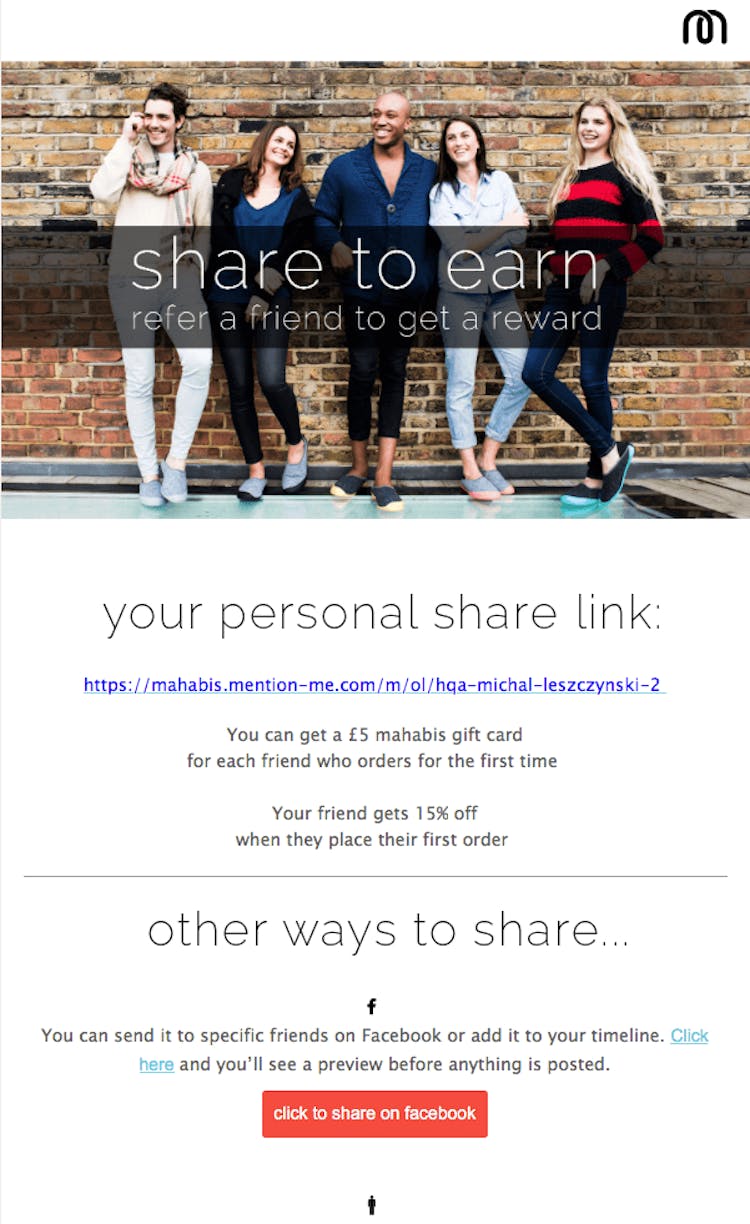
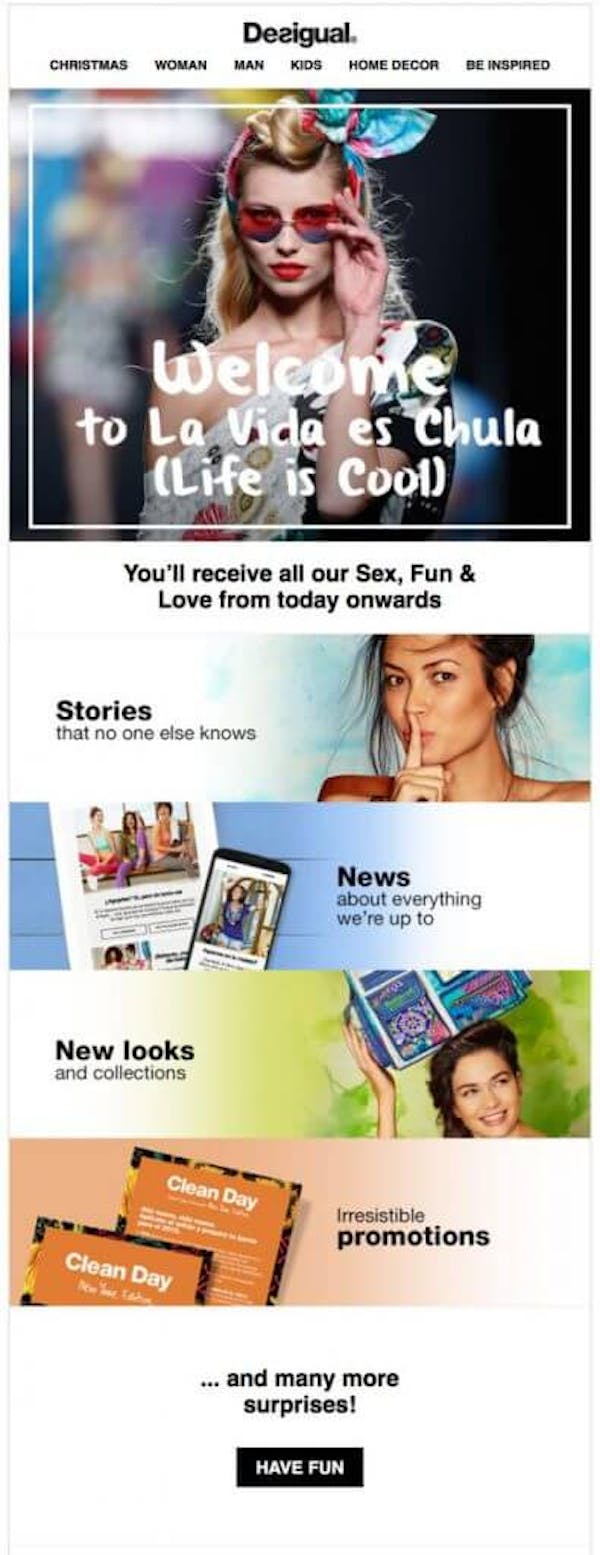
7. Automate What You Can
As I said at the beginning of this article, one of the key benefits of selling online is the possibility of achieving scale. You can do business with thousands of people around the whole globe, regardless of where you're located.
This means that you can deal with all the different kinds of people – from different countries and time zones, too. They could be browsing your site when you're fast asleep. Shopping when you're out for the weekend. Does that mean they should be waiting for your response until you're back in the office?
If you want to maintain a high level of customer service and run your communication effectively, you can't just rely on your physical capabilities. That's why you should automate at least some of your communication efforts. That includes welcome emails, shipping confirmation, up-selling and cross-selling communication, and so on.
While it may seem that automated communication will take away the human factor of your emails, you don't have to worry. Using dynamic content, your messages can be fully personalized so that your subscribers won't tell the difference. Instead, they will be happy to receive their emails on time.
If you're unsure as to what kind of messages can be automated, or whether you need them at all, this article lists more than 20 types of emails your business could be sending today.
Source: Welcome email with useful links from Desigual.
What You Should Do Now
If you've stayed with me this long, I can tell that you're serious about making your post-purchase communication more effective. Why wouldn't you be? If it can make your customer service better and help you sell more, it's only natural you'll want to invest more time into it.
So what you should do now is start writing down what you want your users to do and feel after they have made their purchase. Next start crafting emails that will be sent to them at specified time intervals. This way your brand will stay on their mind long after they have received their order. Then put them into automated workflows and observe how they resonate with your audience.




